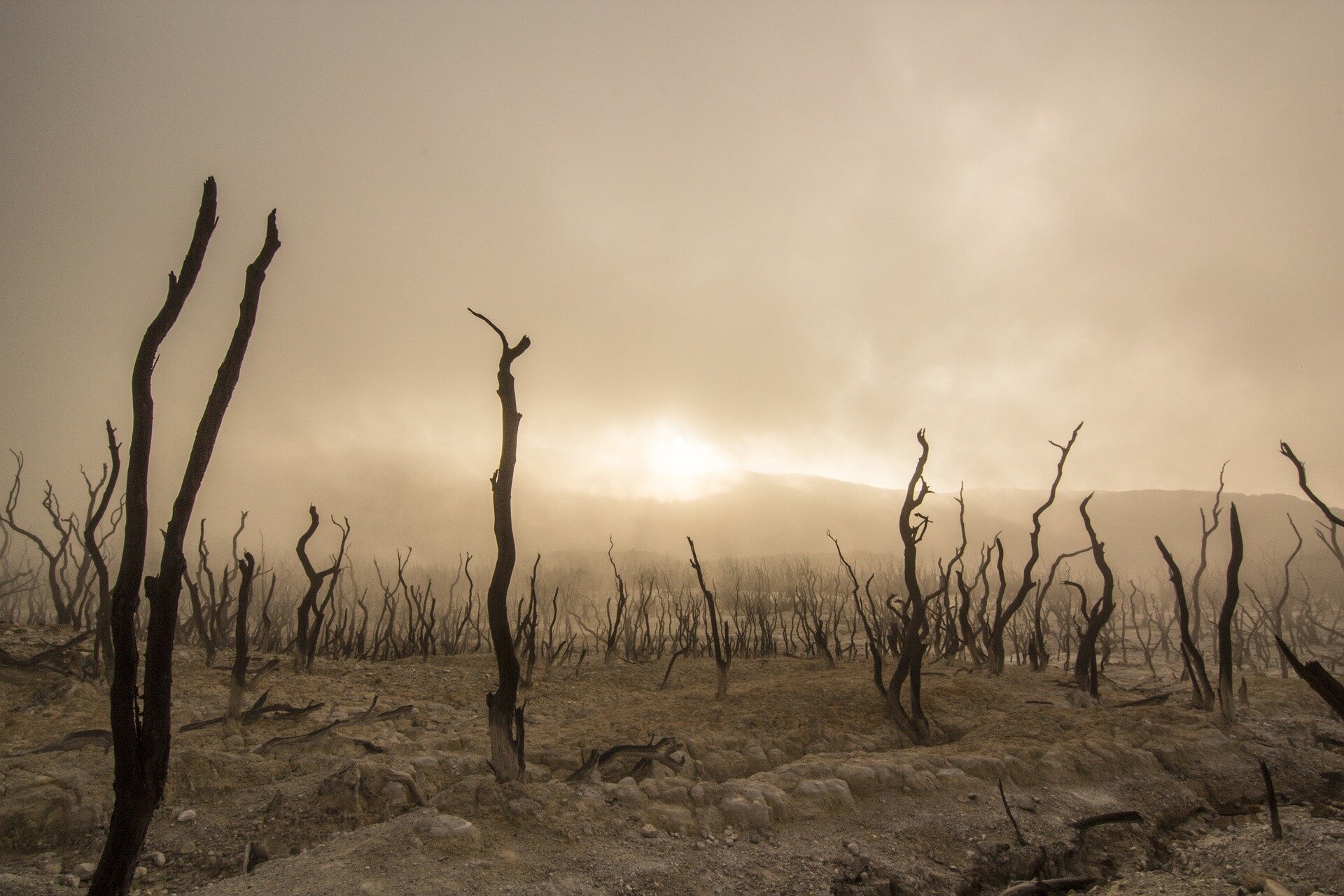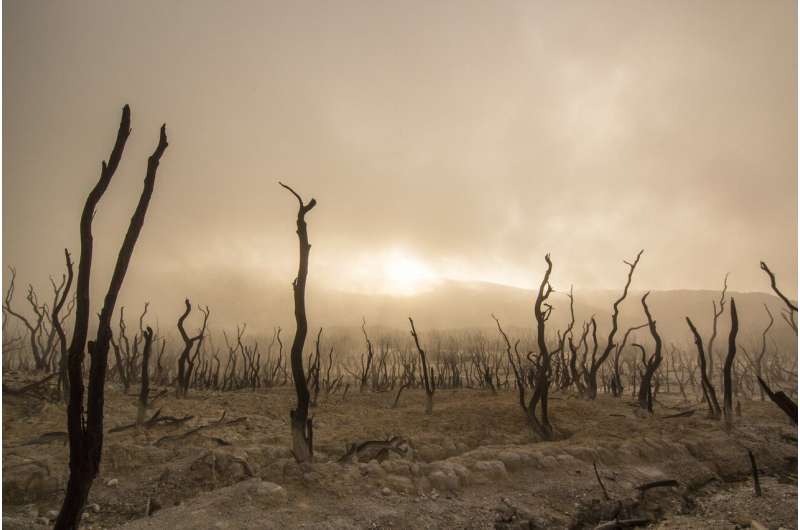

The U.S. Forest Service team that arrived in the Santa Fe National Forest on April 6 had a plan. They would set a small fire and burn away accumulated brush that might fuel a more destructive blaze. Such controlled burns are a key tool in minimizing the risk of raging wildfires, and the Forest Service reported success in 99.84% of its prescribed fires.
But on this day, the team’s time-tested plans and near-perfect track record meant nothing.
Years of drought and hot, windy conditions had sucked moisture from the trees, decaying pine needles and fallen limbs. Logs that typically would have been soaked with water from the previous winter’s snowpack or spring rains and runoff were drier than if they’d been through a wood kiln. Instead of helping to slow the spread of flames or moderate the fire’s temperature, they boosted its intensity.
The fire set by the Forest Service that day escaped its containment lines and blew up into the largest wildfire in New Mexico history, covering 341,000 acres and burning hundreds of homes.
An 80-page review of the incident released in June found firefighters made multiple missteps. A lack of up-to-date weather information contributed to more miscalculations. But one factor stood out: The team had underestimated the risk of the fire burning out of control, a risk exacerbated by the area’s extended drought and hotter temperatures.
“Climate change is leading to conditions on the ground we have never encountered,” Forest Service Chief Randy Moore wrote in the report’s foreword. “Fires are outpacing our models. … We must learn from this event and ensure our decision-making processes, tools, and procedures reflect these changed conditions.”
Scientists have been predicting wild and increasingly extreme weather fluctuations resulting from a warming planet for decades. But events like the New Mexico fire expose a widening gap between a new normal of extremes and a world that prepared for weather events using numbers from a static climate that no longer exists. Consider:
- Across the country, the federal rainfall benchmarks engineers and developers use to plan new roads and buildings are outdated, in some cases by decades, putting the U.S. at risk for more flooding.
- In the Pacific Northwest, few would have believed temperatures could climb as high as 121 degrees in the perennially cool and rainy region—until it happened last year. Hundreds of people died in a heat dome event that struck the last week of June and brought some of the highest temperatures ever recorded there.
- In the West, warnings that drier times were coming haven’t averted the problems caused by a record 22-year megadrought that has threatened drinking water supplies for cities. Lakes are drying up, some crops are failing and many believe decades-old water allocation laws need to be renegotiated.
The problems are likely to get worse, experts say.
“There’s a whole suite of examples where we have pretty sophisticated systems that have been designed and built around assumptions of an old climate,” said Noah Diffenbaugh, a climate scientist at Stanford University. “We’re getting further and further behind.”
Updating models and projections to prepare for increasingly extreme events isn’t easy, he added.
“I’m not saying the scientists haven’t been listened to,” he said. “It would be challenging to design a world that was resilient to climate change from scratch—and it’s much more challenging to do it in the context of other competing priorities and a system built around assumptions of a stationary climate.”
Using the most current numbers—especially when they are so often dire—isn’t always the first choice of policymakers and state and federal agencies, said Kurt Schwabe, a professor of environmental economics and water allocation expert at the University of California, Riverside.
“It’s often just kind of wishful thinking,” Schwabe said, adding that when given a range of possible values, “they often choose a more optimistic one because they want to make things look better for their constituents.”
That approach doesn’t work when every day brings news of temperature records falling, fires raging, and rivers running dry.
“There are things that are happening around the planet that are worsening faster than climate scientists thought they would,” said Jonathan Overpeck, a climate scientist and dean of the University of Michigan’s School for Environment and Sustainability. “Managers are still coming to grips with the severity of it and how fast it’s changing.”
Outdated weather projections
The changing climate isn’t just outpacing fire models. U.S. TODAY documented the increasing impacts of weather extremes such as drought and rainfall in an investigation published in December. A month later, the newspaper reported that official precipitation frequency estimates are outdated in at least 18 states, some by as much as 50 years. And the estimates, some conducted on a state or regional basis, have never taken into account the increase in intense rainfall projected by climate change.
When Texas officials met with the National Weather Service in 2018 to update their decades-old benchmarks, they found that the likelihood of a 100-year storm—meaning there’s a 1-in-100 chance of such a storm in any given year—had quadrupled in Houston.
The outdated figures leave much of the country vulnerable to more flooding.
“We have a broken national process for understanding and predicting the relationship between rainfall and frequency,” Chad Berginnis, executive director of the Association of Floodplain Managers told U.S. TODAY in January.
A bill that would require the National Weather Service to work out a more comprehensive way of doing rainfall estimates and updating them more often passed the U.S. House in May with bipartisan support. No vote has occurred in the Senate.
People are already paying the price for living with outdated weather projections in the West. One example is water allocation from the Colorado River. A legal agreement among seven Western states set water rights “in perpetuity”—written in 1922 and based on flows measured in the early 1900s, an exceptionally wet period.
“It’s never had that much water since, and it’s less and less, so they’re not going to have that much water again,” said Gerald Meehl, a senior scientist at the National Center for Atmospheric Research who was part of the team that won the Nobel Prize in 2007 for its work on climate change.
While nobody was giving much thought to climate change a hundred years ago, the failure to plan for the future has persisted through a megadrought in the West that’s lasted more than two decades and is the region’s worst in 1,200 years.
“What we used to think of as normal is no longer normal,” said Jay Famiglietti, a hydrologist who directs the Global Institute for Water Security at the University of Saskatchewan in Canada. “Coming to grips with that and building our infrastructure accordingly is the problem.”
“The speed at which the severity of the drought increases, the pace of groundwater depletion, the pace at which ice is melting, these are all things that are changing much faster than we can keep up with,” he said.
In the end, all the climate and weather models in the world won’t fix the problems we face, said Overpeck, the University of Michigan climate scientist. That will require the political will to both rapidly lower carbon dioxide levels in the atmosphere to address the root cause of climate change and prepare for the different climate that’s heading our way.
“Really, what we should be doing is building and planning for the future,” he said. “The question is, what is that future? The problem with answering that isn’t our climate models, it’s our political system. We can’t predict what our leaders are going to do—or not do.”
Getting the right info to the right people
Most government planning and infrastructure decisions are based on extrapolations of weather patterns. If a state has rainfall records going back 140 years, it calculates how often cloudbursts have happened during that time and assigns a likelihood that a real gully-washer will hit based on that history.
But those estimates are based on the relatively stable climate the Earth has enjoyed for thousands of years.
That stability is now gone. Over the past 6,000 years, the level of carbon dioxide in the atmosphere has held steady at around 280 parts per million. That began to change during the Industrial Revolution, when humanity began burning enormous amounts of coal and oil, pumping ever larger amounts of carbon dioxide into the atmosphere. In June it hit 420. Such levels haven’t been seen in millions of years, since Earth was a hothouse, ocean-inundated planet.
Part of the problem, climate scientists concede, is that the weather fluctuations they began predicting decades ago were so extreme they could be ignored as unlikely by those making decisions on how to plan for the future.
Now that future has arrived, earlier than some expected, but that doesn’t always make it easier for people to accept what the new climate models say is coming, said Meehl with the National Center for Atmospheric Research.
“If you’re a forecaster, you have to start to think ‘We’re in a new world,'” he said. “When you start seeing records broken, that means you’re going into uncharted territory.”
For a time, even the scientists were conservative in how they interpreted the data.
Scientists run climate models thousands of times, watching the outputs change as they use different variables. Overall, the models are quite good, they say.
The models predicted more extreme events as the Earth warms and the weather grows more erratic. Those “spikes” show up more often, said Brett Anderson, a senior meteorologist with AccuWeather. “For 20 years now, we’ve been told that drier areas are going to get drier and wetter areas are going to get wetter,” he said.
But in the past, weather modelers tended to average things out because that made for better forecasts. “But maybe we need to pay attention to those spikes and not rule them out anymore,” Anderson said.
An example of such a spike was the heat dome that baked Oregon, Washington and Canada’s British Columbia in June 2021. Temperatures hit 108 in Seattle and 112 in Portland. An after-action report prepared for Oregon Gov. Kate Brown called the event “unprecedented.”
Yet while it was true that such temperatures hadn’t been reported there before, the models run by Meehl and colleagues had predicted such heat waves in the Pacific Northwest—in a paper published 18 years earlier.
The Oregon report noted the state emergency operations plan had contingencies in place for droughts, earthquakes, floods, tsunamis, wildfires and terrorism—but not for excessive heat. Numerous recommendations were offered for better preparing the state for future heat waves, noting the events of that summer were not anomalies but indicators of what the state will face in the future.
“While efforts must continue to slow and stop the factors contributing to climate change, we must also develop immediate and long-term strategies to adapt to today’s changing climate,” the report stated.
Scientists are hoping to see more consideration for extreme events. Plans can no longer be made based on what’s happened in the past because the future is going to be very, very different, said Daniel Swain, a climate scientist at the University of California, Los Angeles.
“We need to have greater imaginations when thinking about the hazards,” he said. “We need to be thinking about climate change everywhere all the time in the context of all the infrastructure we have, both existing and especially new.”
Extreme heat waves expected to intensify as global temperatures rise, says expert
(c)2022 USA Today
Distributed by Tribune Content Agency, LLC.
Citation:
Climate change exposes growing gap between weather we’ve planned for—and what’s coming (2022, July 28)
retrieved 28 July 2022
from https://phys.org/news/2022-07-climate-exposes-gap-weather-weve.html
This document is subject to copyright. Apart from any fair dealing for the purpose of private study or research, no
part may be reproduced without the written permission. The content is provided for information purposes only.